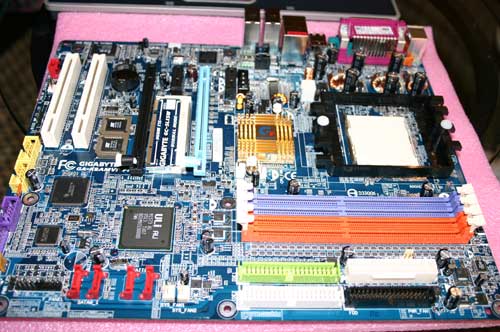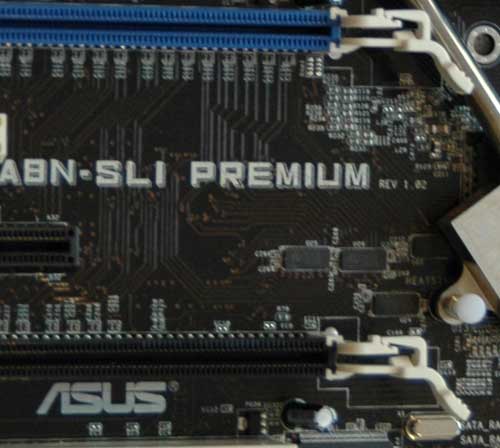ATI's Multi-GPU Solution: CrossFire
by Anand Lal Shimpi & Derek Wilson on May 30, 2005 9:00 PM EST- Posted in
- GPUs
What Happened to the Selector Card?
One of ATI's most interesting claims with their CrossFire solution is that you no longer need the selector card that is seen on nForce4 SLI motherboards. How is it that ATI is able to get around this requirement? Contrary to popular belief, it's not magic.By default, the nForce4 SLI chipset sends all 16 PCI Express lanes from the North Bridge to the first PCI Express x16 slot on a nForce4 SLI motherboard.
Flipping the selector card the other way divides the PCI Express lanes and sends the first 8 lanes to the first slot and the remaining 8 lanes to the second slot.
ATI's MVP chipset works slightly differently; by default, the North Bridge sends 8 PCI Express lanes to each of the two PCI Express slots. If you have two cards installed, then this is the desired configuration. However, if you only have one card installed, in order to get a full PCI Express x16 slot, one of the following methods must be implemented by the motherboard manufacturer:
Option 1 - Terminator Card
The first option is a terminator card that is installed into the second PCI Express x16 slot. This card simply reroutes the 8 PCI Express lanes going into the slot back to the first PCI Express slot, giving it all 16 PCI Express lanes.

Obviously, the downside to this approach is that you have to use a terminator card; we haven't heard of many manufacturers doing this.
Option 2 - SLI Selector Card
The second option is to implement the same selector card that is used in nForce4 SLI motherboards. If you want a single x16 slot, flip the card one way. If you want two x8 slots, just change its orientation and you are good to go.

The obvious downside here is that the user has to play with the selector card, something that ATI wants to avoid. Despite ATI's desire to avoid this card, some manufacturers are implementing it:

Option 3 - Selector ICs
The third (and most expensive) option is for the motherboard manufacturer to place a series of selector ICs (Integrated Circuits) on the motherboard itself, which will allow for the user to switch between one x16 slot or two x8 slots from within the BIOS. This is the most desired implementation from the end user's standpoint, but it is the most expensive option.
Either 4 or 5 chips have to be placed on the motherboard in order to allow for this software-selection of PCI Express configuration. Each chip costs the motherboard manufacturer approximately $1, which isn't really a problem for high end motherboards.

Note that there is also no reason why the same technology can't be implemented on nForce4 SLI motherboards; in fact, ASUS has already implemented it on their latest nForce4 SLI solution:











57 Comments
View All Comments
Calin - Tuesday, May 31, 2005 - link
"ATI should be focused on the overall platform, not necessarily building up support for their South Bridge. Although we do think it is a bit embarrassing to have to turn to another chipset vendor to provide working South Bridges for your motherboard partners. It would be one thing if this were ATI's first chipset, but it most definitely is not. "AMD first chipset (AMD 760 for Slot A Athlon, or Irongate, I think) had also non working USB support (or very buggy). Most mainboard manufacturers offered USB thru an add in PCI card, in order not to use the one included in the southbridge
Googer - Tuesday, May 31, 2005 - link
In theroy since It connets to the other card through DVI, I could use my old 9700pro in Crossfire mode with the newer card; even better is what if I could use an NVIDA card and ATI card in Crossfire! All I need is that moterhboard (if forgot the make and model) that supports PCI-e and Ture AGP! (not pci based agp)FakeName - Tuesday, May 31, 2005 - link
This is bogus, remember accelerator cards, mid-90's... poor solution then, same poor solution again... don't waste your hard earned money on this cerebral shortfall, the next gen will soon be upon us...Shinei - Tuesday, May 31, 2005 - link
Performance looks promising, sure, but I wonder what will be shown when AT gets hold of a sample for longer than a few benchmark runs--an 85% improvement at 1600x1200 seems a bit strange, particularly for hardware known for wheezing in the benchmarked game...CrystalBay - Tuesday, May 31, 2005 - link
Very sophisticated approach ATI...Hopefully the Composter doesn't turn to sh!t later on...sprockkets - Tuesday, May 31, 2005 - link
Hmmm, isn't the current SB on existing Radeon Express 200 boards buggy too?overclockingoodness - Tuesday, May 31, 2005 - link
#15: Regardless, what difference does it make? The performance would still be closer to what's presented in the article.overclockingoodness - Tuesday, May 31, 2005 - link
#15: You need to read more carefully. Notice how they said that it was the vendor's PC and not their own. So, obviously they had no choice. They had to go by whatever the vendor was offering at the time.flatblastard - Monday, May 30, 2005 - link
I was a little bummed after reading that the Crossfire + Xpress 200 would also have 2xPCI-e slots instead of just one like the current msi rs480m2-il. I was even more disappointed to here about the current state of the sb450. I thought the sb450 was supposed to fix the bugginess of sb400 which it is replacing? Oh well, no big suprise I guess considering their history in that department. So here's hoping for another save from uli.bob661 - Monday, May 30, 2005 - link
#16They weren't listed so I would imagine that they won't be compatible.